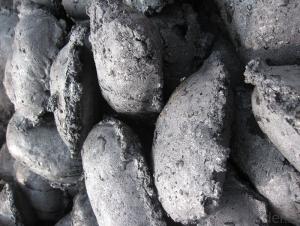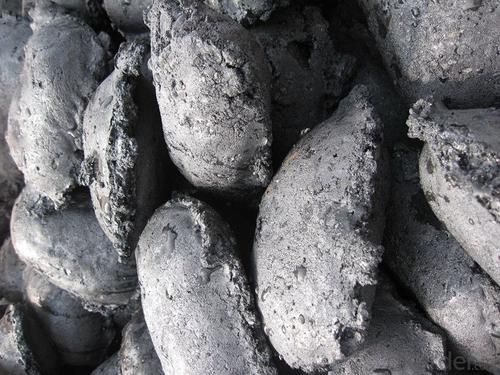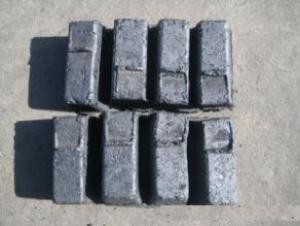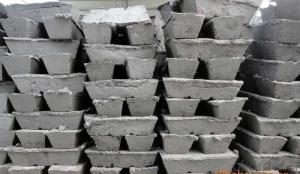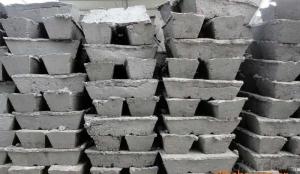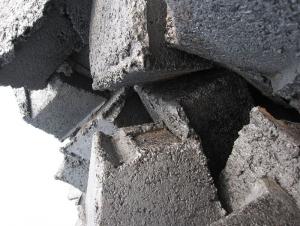Carbon Electrode Paste with Low Ash And Good Quality
- Loading Port:
- Lianyungang
- Payment Terms:
- TT or LC
- Min Order Qty:
- 20 m.t.
- Supply Capability:
- 2000 m.t./month
OKorder Service Pledge
OKorder Financial Service
You Might Also Like
INTRODUCTION
Carbon Electrode Paste is a self-baking electrode used in submerged arc furnaces for delivering power to the charge mix.
Electrode Paste is added to the top of the electrode column in either cylindrical or briquette form. As the paste moves down the electrode column the temperature increase causes the paste to melt and subsequently bake forming a block of electrically conductive carbon. Electrode Paste is essentially a mix of Electrically Calcined Anthracite (ECA) or Calcined Petroleum Coke (CPC) with Coal Tar Pitch.
Graphite/Carbon Electrode Paste Specification:
Ash.( % ) 4.0 max 5.0 max 6.0 max 7.0 max 9.0 max1 1.0 max
V.M (%) 12.0-15.5 12.0-15.5 12.0-15.5 9.5-13.5 11.5-15.5 11.5-15.5
Compress Strength. 18.0 min 17 min 15.7 min 19.6 min 19.6 min 19.6 min
Specific Resistance 65 max 68 max 75 max 80 max 90 max 90 max
Bulk Density 1.38 min 1.38 min1 .38 min 1.38 min 1.38 min 1.38 min
Picture:
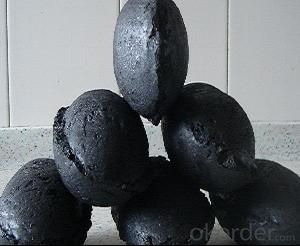
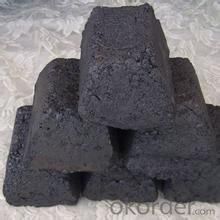
PACKAGE
In mt jumbo bag or as buyer's request
- Q: Glucose contains resveratrol (C14H12O3) to determine the mass ratio of resveratrol and carbon dioxide of the same quality as carbon dioxide
- They are x and y, containing carbon equal, according to the mass of an element = the mass of a compound * the elementMass fractionFor C14H12O3, the carbon mass fraction is C%=12*14/ (12*14+12+16*3) *100%=73.68%For CO2, the mass fraction of carbon is 12/ (12+16*2) =27.27%There is x *73.68%=y*27.27%So there's X: y =57:154
- Q: What are the effects of carbon emissions on the stability of mangrove forests?
- The stability of mangrove forests is significantly impacted by carbon emissions. These ecosystems are highly vulnerable to climate changes, and increased carbon emissions contribute directly to global warming and climate change. One of the main consequences of carbon emissions on mangrove forests is the rise in sea levels. When carbon dioxide is released into the atmosphere, it traps heat and warms the planet. This, in turn, causes the melting of polar ice caps and glaciers, resulting in higher sea levels. The increased sea levels pose a threat to mangroves as they are adapted to grow in areas where they are exposed to both saltwater and freshwater. With rising sea levels, mangroves may experience more flooding, which can lead to their submersion and eventual death. Additionally, carbon emissions also play a role in ocean acidification. When carbon dioxide dissolves in seawater, it creates carbonic acid, which alters the pH balance of the ocean. Mangroves rely on the ocean for their nutrients and reproductive processes. Ocean acidification can hinder the availability of vital nutrients like nitrogen and phosphorus, necessary for the growth and survival of mangroves. Furthermore, the acidification of seawater can negatively impact the reproduction and development of mangrove species, leading to a decline in their population. Furthermore, carbon emissions contribute to changes in weather patterns, including an increase in the frequency and intensity of storms and hurricanes. Mangroves serve as natural barriers that protect coastal areas from the destructive impacts of these extreme weather events. However, with intensified storms and hurricanes, the stability of mangrove forests is compromised. Strong winds, heavy rainfall, and storm surges can uproot or damage mangrove trees, disrupting their structure and reducing their ability to provide coastal protection. Finally, carbon emissions also contribute to the overall warming of the planet, which can result in changes in precipitation patterns. Mangroves rely on a delicate balance of freshwater and saltwater for their survival. Alterations in precipitation patterns, such as prolonged droughts or increased rainfall, can disrupt this balance and have negative effects on mangroves. Droughts can cause water scarcity, stressing mangroves and making them more susceptible to diseases and pests. Conversely, excessive rainfall can dilute the salinity of mangrove habitats, affecting their growth and reproduction. In conclusion, carbon emissions have harmful effects on the stability of mangrove forests. Rising sea levels, ocean acidification, changes in weather patterns, and alterations in precipitation patterns all contribute to the degradation and loss of mangrove ecosystems. It is crucial to reduce carbon emissions and mitigate the effects of climate change to ensure the long-term survival and stability of mangrove forests.
- Q: How does carbon impact the prevalence of earthquakes?
- The prevalence of earthquakes is not directly influenced by carbon. Instead, earthquakes are primarily caused by the movement of tectonic plates, which are massive sections of the Earth's crust that float on the semi-fluid layer beneath. When these plates collide, slide past each other, or separate, seismic waves are released, resulting in an earthquake. On the other hand, carbon is a chemical element that exists in various forms in the Earth's atmosphere, oceans, and living organisms. Human activities, such as emitting carbon dioxide (CO2), contribute to climate change and impact the Earth's ecosystems. However, there is no direct connection between carbon emissions and the prevalence of earthquakes. Nevertheless, it is important to note that some geologists and scientists suggest that human activities, such as extracting fossil fuels, may indirectly affect seismic activity. The extraction of large quantities of oil, gas, or water from the Earth's crust can potentially alter underground pressure and stress distribution, potentially triggering induced earthquakes. These induced earthquakes are usually of low magnitude and limited to the specific extraction area. Overall, while carbon emissions and human activities may have some localized impact on seismic activity, the global prevalence of earthquakes is mainly driven by tectonic plate movements and is not directly influenced by carbon.
- Q: Often see the so-called 30T, 46T, 60T carbon fiber, 60T carbon fiber, equivalent to T hundreds of carbon fibers, is T800, or T1000? I'm not very good at parameter conversion. Is there a parameter list? How do I correspond to the T300T700T800 performance parameter table?
- Three, T300, T700, T800, T1000 intensity were 3530MPa, 4900MPa, 5880MPa, 6370MPa;The intensities of M46 and M60 were 4020MPa and 3820MPa respectively.
- Q: How does carbon contribute to air pollution?
- Carbon contributes to air pollution primarily through the combustion of fossil fuels. When carbon-based fuels such as coal, oil, and natural gas are burned for energy, they release carbon dioxide (CO2) into the atmosphere, which is a greenhouse gas that contributes to global warming and climate change. Additionally, incomplete combustion of these fuels can produce other pollutants such as carbon monoxide (CO), volatile organic compounds (VOCs), and particulate matter, which all have detrimental effects on air quality and human health.
- Q: Just come out to work, do activated carbon, often see carbon materials and carbon materials, I do not know what the difference, trouble you!
- Carbon materials are usually specified, especially carbon and graphite materialsCarbon material is a broad carbon containing materialAbove.
- Q: What are the consequences of increased carbon emissions on global food security?
- Global food security is significantly impacted by increased carbon emissions, with a range of consequences. One immediate effect is the alteration of weather patterns and an increase in extreme weather events, such as droughts, floods, and heatwaves. These events can result in crop failures, reduced agricultural productivity, and the loss of livestock, ultimately leading to food shortages and price instability. In addition, carbon emissions contribute to climate change, which causes long-term shifts in temperature and precipitation patterns. Higher temperatures can accelerate the growth and reproduction rates of pests and diseases, posing a severe threat to crops and livestock. Furthermore, changes in rainfall patterns can disrupt the timing and quantity of water available for irrigation, further reducing agricultural productivity. Moreover, carbon emissions contribute to ocean acidification, negatively impacting marine ecosystems and the livelihoods of fishing and aquaculture communities. This can result in a decline in fish stocks, jeopardizing an essential source of protein and nutrition for millions of people. Increased carbon emissions also lead to the loss of biodiversity. Climate change disrupts ecosystems, leading to the extinction or migration of plant and animal species. This loss of biodiversity reduces the resilience and adaptability of agricultural systems, making them more susceptible to pests, diseases, and environmental pressures. Ultimately, the consequences of increased carbon emissions on global food security are extensive and intricate. They include diminished agricultural productivity, rising food prices, food shortages, and limited access to nutritious food. Addressing carbon emissions and mitigating climate change is vital to ensure a sustainable and secure global food system for future generations.
- Q: How does carbon affect the formation of blizzards?
- Blizzards, characterized by strong winds, low temperatures, and heavy snowfall, are not directly affected by carbon. Blizzards typically occur when a low-pressure system moves into an area with enough moisture and cold air. Temperature, moisture, and wind patterns are the main factors that influence the formation of blizzards. Nevertheless, carbon emissions and their impact on the climate can indirectly affect the frequency and intensity of blizzards. Carbon dioxide (CO2) and other greenhouse gases trap heat in the atmosphere, causing global warming. This warming effect can change weather patterns, including the conditions required for blizzard formation. Carbon emissions can lead to warmer temperatures, altering precipitation patterns and increasing moisture in the atmosphere. This additional moisture, along with the necessary cold air, can contribute to heavier snowfall during blizzards. Furthermore, climate change can influence wind patterns, impacting the intensity and duration of blizzards. Changes in atmospheric circulation patterns can modify the tracks and strength of storms, potentially resulting in more or fewer blizzard events in specific regions. It is worth noting that the specific impact of carbon emissions on blizzard formation varies depending on regional and local factors. The intricate nature of weather systems and the interaction between different variables make it difficult to attribute any single weather event solely to carbon emissions. However, the overall influence of carbon emissions on the climate system increases the potential for more extreme weather events, including blizzards.
- Q: What is the significance of the determination of total organic carbon in purified water?
- The first tube with 5 drops of nitric acid and silver nitrate solution 1ml second tube plus barium chloride solution 2ml third tube plus ammonium oxalate solution 2ml, are not allowed to turbidity. Take this product 5ml nitrate test tube, in ice bath cooling, adding 10% potassium chloride solution and 0.1% 0.4ml aniline two 0.1ml sulfuric acid solution, then slowly adding sulfuric acid 5ml, shake the tube in 50 DEG C water bath for 15 minutes, the solution with the standard blue nitrate solution [for potassium nitrate 0.163g, dissolved in water and diluted to 100ml, shake, precise amount of water into 1ml, 100ml, then the precise amount of water into 10ml, 100ml, and the (per 1ml equivalent to 1 gNO3]0.3ml), with no nitrate water 4.7ml, compared with the same method after color not more, (0.000006%). Nitrite to take this product 10ml, the Nessler tube, and sulfanilamide dilute hydrochloric acid solution (1, 100) and 1ml hydrochloride Naphthylethylenediamine (0.1 - 100) 1ml solution, the pink, and the standard solution of sodium nitrite and nitrite [0.750g (calculated on dry goods), dissolved in water, dilute to 100ml, shake, precise amount of water into 1ml, 100ml, and then precise amount of water into 1ml, 50ml, and the (equivalent to 1 gNO2 per 1ml) 0.2ml), plus nitrite free water 9.8ml, compared with the same method after color, shall not be deeper (.000002%). Take this product 50ml ammonia, alkaline potassium tetraiodomercurate solution 2ml, placed 15 minutes; such as color, with ammonium chloride solution (from ammonium chloride 31.5mg, and no amount of ammonia dissolved and diluted into 1000ml 1.5ml), compared with alkaline solution and free ammonia 48ml iodine potassium iodide solution made from 2ml, not deeper (0.00003%).
- Q: How are carbon nanotubes produced?
- Carbon nanotubes are typically produced through a process called chemical vapor deposition (CVD), where a carbon-containing gas is introduced into a high-temperature reactor. Under controlled conditions, the carbon atoms assemble and form nanotubes on a catalyst surface, such as iron or nickel. Other methods, including arc discharge and laser ablation, can also be used to produce carbon nanotubes.
Send your message to us
Carbon Electrode Paste with Low Ash And Good Quality
- Loading Port:
- Lianyungang
- Payment Terms:
- TT or LC
- Min Order Qty:
- 20 m.t.
- Supply Capability:
- 2000 m.t./month
OKorder Service Pledge
OKorder Financial Service
Similar products
Hot products
Hot Searches
